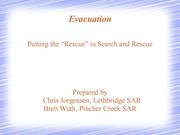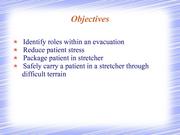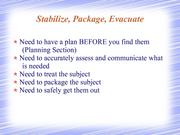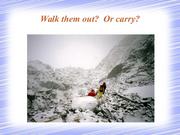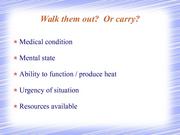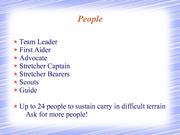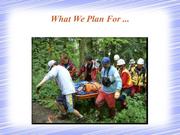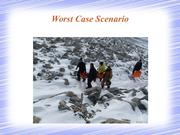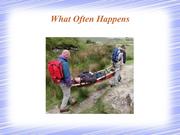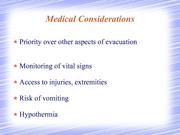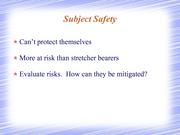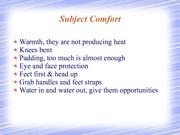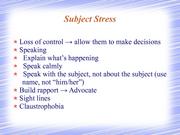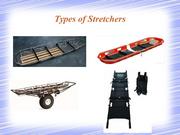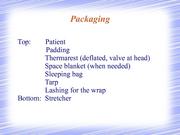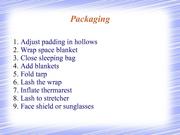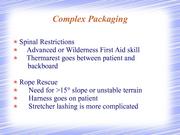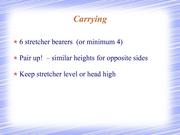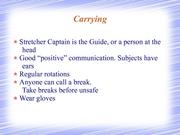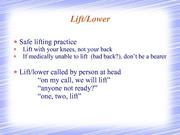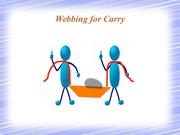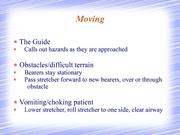SAR Fundamentals/Evacuation
From PCSAR
Contents |
[edit] Subject
What is this lesson plan about?
Moving the subject after they have been located.
[edit] Authors
List who wrote this lesson plan.
[edit] Scope
What is included in this lesson, what's not and why.
- Addresses part of CSA Z1625 4.4.1
- part of T1. First aid procedures related to relevant search environment.
- SAR Fundamentals Manual: Ch.26 "Evacuation"
- Basic SAR Skills Manual: Ch.23 "Rescue and Evacuation"
- include litter carry / patient packaging
- does not include spinal restriction / C-collar / backboard
[edit] Prerequisites
What should students already know/have accomplished before the lesson is presented.
[edit] Objectives
At the conclusion of this lesson the participants:
- can identify roles within an evacuation
- can reduce patient stress
- can package patient in stretcher
- can safely carry a patient in a stretcher through terrain difficulties
[edit] Time Plan
Total Time: 40 minutes lecture, 30 minute practice
- 2013-02: 25 min
| Time | Material
|
|
00:00 3 min |
Introduce topic title Introduce Instructor Present Objectives
|
|
00:03 1 min |
Evacuation Concept
|
|
00:04 2 min |
Carry vs. ...
|
|
00:06 3 min |
Roles in Evacuation inner circle (medical) vs. outer circle (rescue)
Additional resources will be sent in
|
|
00:09 2 min |
Medical Considerations
|
|
00:11 2 min |
Subject Safety
|
|
00:13 2 min |
Subject Comfort
|
|
00:15 3 min |
Subject Stress
|
|
00:18 3 min |
Types of Stretchers
|
|
00:21 23 min |
Order of Packaging - No backboard - theory demonstrate packaging (add 10 minutes)
|
|
00:24 3 min |
Complex Packaging spinal restrictions
rope rescue
People with these higher level skills will be brought in to work with you on packaging
|
|
00:27 1 min |
Carrying
|
|
00:28 2 min |
Rotation
|
|
00:30 1 min |
Carrying - cont.
|
|
00:31 1 min |
Lift/Lower
|
|
00:32 1 min |
Carrying Straps
|
|
00:33 2 min |
Moving exercise: resume the carry, adding complications of terrain to bring out the following points
|
|
00:35 30 min |
Exercise practice wrap practice raise/lower practice carry practice rotation navigate obstacles
|
|
01:05 5 min |
Questions |
[edit] Aids
What materials are needed or useful in presenting this lesson.
- slides (download/print: .pdf; edit: .odp)
- wire mesh stretcher
- webbing
- 6 x 5m
- 1 x 10+m or 2 x 7m
- improvised terrain or obstacles
[edit] References
- non-publishable material
- Slide show for Evacuation Lesson by Chris Jorgensen
- Training/Ideas/First aid
- Image:Members:Short History of Stretchers.pdf
- BICO Module #3 Snowmobiler Basic Tx Principles (10 min video)
[edit] Question bank
List of questions suitable for an review/exam of this section.
See Question bank
[edit] Frequently Asked Questions
What are some of the questions that students typically ask. Include the answers.
[edit] Feedback
When has this lesson been presented. What was the feedback.
[edit] License
What can others do with this lesson?
Recommended license below. Fill in the year and the author's name(s):
Copyright © 2013-2018, Chris Jorgensen, Brett Wuth. This work is licensed under a Creative Commons Attribution-NonCommercial 2.5 Canada License. To view a copy of this license, visit http://creativecommons.org/licenses/by-nc/2.5/ca/ or send a letter to Creative Commons, 559 Nathan Abbott Way, Stanford, California 94305, USA.
[edit] Reference Material
If you need to cite sources, do so here.
[1]
[edit] Notes
Any additional notes, etc.
